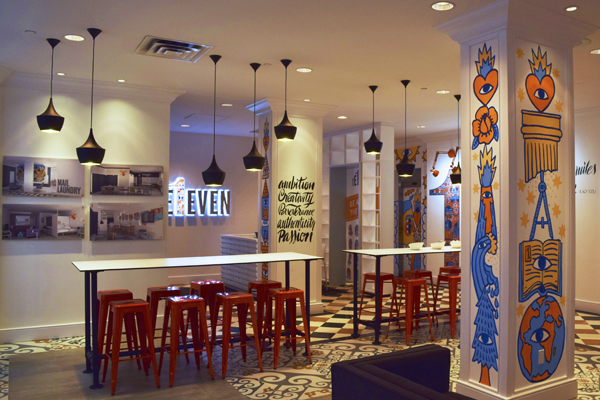Private developers have begun flooding Ottawa’s student housing market with new residences, but the pace of construction may not be sustainable.
Photos by Douglas Sprott, Justin Dallaire, and Remi Yuan
Inside a construction site trailer at 45 Mann Ave., Barry Hauer examines the floor plans for the nine-storey, 120-unit student housing building that will neighbour the Minto Sports Complex come September 2016.
He pinpoints the location of what will be the gym, before flipping to the games room, then the business centre, then the rooftop terrace. There are even plans for a free coffee bar in the lobby.
“If you’re designing a building from scratch, and you have in mind that it should be for students, you design things differently,” he says.
The building’s one- to four-bedroom units will each have a full kitchen, laundry machines, and the same number of bathrooms as there are bedrooms. Everything about it has been expressly designed for students. Hauer says he hopes this will attract the business of those who are struggling to find decent accommodations near campus.
And he’s not the only developer with his eye on this part of town. Many others are looking to capitalize on the University of Ottawa’s burgeoning student housing market.
It all started in 2013 with the closing of a retirement residence at 353 Friel Street. The building was gutted and rebuilt into Sandy Hill Apartments, “the latest in luxurious studio apartments.” The pitch? Semi-furnished, high-end finishes, all-inclusive rent.
Others have been doing the same ever since.
At 111 Cooper St., just over the Corktown footbridge, an old Holiday Inn is being converted into 1Eleven, a 220-unit apartment building that will welcome as many as 420 tenants in September.
To the east, a block and a half from campus, lies the future home of another housing project. Following a protracted battle with the city, Viner Assets recieved permission from the Ontario Municipal Board to proceed with replacing the six buildings on the corner of Laurier and Friel with one nine-storey housing facility covering an acre of prime Sandy Hill real estate. It’s set to open sometime in 2017.
Together the Mann, Cooper and Laurier-Friel buildings will add more than 1,200 private housing beds within walking distance of the university over the next two to three years. And that doesn’t account for the many small-scale housing projects that continue to sprout up like dandelions.
This comes at a time when the university has struggled to find space on campus for new housing projects that would allow it to continue guaranteeing residence to first-year students. “For every piece of open property you see on the campus, we have something in mind,” U of O president Allan Rock told the Fulcrum last year.
While each building promises to be different than the others, all of them are part of a recent housing trend aimed at upper-year university students as they transition out of residence. Hauer says he expects first-year students will continue wanting to live in university residences, and he’s OK with that.
“We don’t look for first-year students at all,” he says. “We are looking for people leaving residence who want to still live in student housing as opposed to living by themselves.”
The three properties will be privately owned and managed, meaning they can rent to anyone who’s willing to pay. Henry Morton, president of Campus Suites, one of the co-developers of 1Eleven, says they would welcome students from other schools or Ottawa residents looking for short-term stays.
“Our focus is really student-oriented, but we are indifferent whether we’re appealing to University of Ottawa students, Carleton students, or even Saint Paul students,” says Morton.
While private developers have come to see the U of O as a golden opportunity, they aren’t the only ones looking to relieve the school’s housing shortage. The university’s Housing Service continues to do its part as well. In September 2014, it opened a residence at the intersection of Friel and Rideau Streets. It has also invested $17.5 million in a new four-storey residence on Henderson Avenue, which is expected to open this coming September. By then, Housing Service alone will have added close to 600 university-run living spaces since 2014.
Housing Service’s short-term plan is to provide 1,200 additional beds for first-year students, but longer-term the university stated it will need 8,000 new beds to meet student needs, as revealed in the campus’s master plan overview on Mar.10
All of this suggests things are changing—and changing fast. When all is said and done, the U of O’s student housing market will have undergone a dramatic transformation. While the university’s shortage of on-campus real estate has opened up fruitful opportunities to private developers, it’s the students who stand to profit the most.
Life in private housing
Barbara Nzigiye is an international student who has been working as a community advisor in Marchand for the past two years. Although she has never lived off campus, she has friends who have lived in apartments around Ottawa. Nzigiye says she has heard really good things and really bad things.
“That’s where I think the gamble is,” she says. “And that’s why I would prefer personally to be somewhere more structured. Especially as an international student.”
While the private housing projects on Mann, Cooper, and Laurier-Friel have no affiliation with the U of O, they nevertheless promise to offer structure and a student-friendly environment to their tenants. Hauer says that from a management perspective Mann will resemble university-run residences, but that it will be less strict when it comes to its clients and operations. The same goes for 1Eleven.
“You’ll see a lot of the same characteristics,” Morton told the Fulcrum last month. “But a lot of it is in the fact that this is not the university, so we do not have the same true guidelines as the university does.”
Another benefit to prospective renters is that the new buildings will be just that—new. Whereas many U of O residences date back to the ‘60s and ‘70s, the new housing projects will be modern and trendy and will come equipped with numerous amenities.
Doris Riznavolli, a U of O alumnus who has looked into 1Eleven, says the building seems spacious and modern. “I also think the prices and locations are perfect,” she wrote to the Fulcrum. “I feel like student residences on campus often look rundown and dated, not to mention how small some of the spaces are in square footage.”
Fully furnished, all-inclusive rentals in residence-style apartment buildings can be particularly advantageous for students who are from out of town. Those like Nzigiye who have never needed to purchase furnishings of their own may now never need to.
“I’m probably not going to be staying in Ottawa after my studies, so not needing to buy furniture would be helpful,” she explains.
As a community advisor, Nzigiye provides a lot of information to first-years regarding their off-campus housing options. She says students take into account a variety of factors when choosing where to live after first year, and that it “really depends on personal preferences.” She says proximity to the school, price, and student environment are all important factors. In some ways, the new properties will appeal to some of these factors.
“The thing that people I know who lived in residence miss the most is that student environment, and having that at a different level is super interesting.”
Of course, it all comes at a price. Students moving into 1Eleven, for example, can expect to pay between $750 and $1,475 per month.
An evolving housing market
The city of Waterloo offers a glimpse into what might be in store for the U of O. There was a time when the students at the University of Waterloo and Laurier University would cram into dilapidated housing conversions much like Sandy Hill in Ottawa. Today, the scene is rather different.
Of the approximate 20,000 beds of private student housing in Canada, about half of them are in Waterloo. Another 4,000 beds were planned or in construction at the time of an August article published in the Toronto Star. The buildings have done a lot to improve housing conditions in the city, but the market may be reaching a saturation point.
“There are mounting concerns that it’s simply too much student housing for the demand,” the article states. “Some Waterloo developers have started cutting rents, or offering grocery vouchers, to keep good tenants.”
Whether Ottawa is heading in the same direction depends on whom you ask. Karen Rowan, who has been with Fleming Property Management for 16 years, says she believes the added spaces will merely satisfy a growing need.
“I would say that there’s not near enough housing for students. Every September we get calls and people are desperate for places, so I don’t see it having any negative impact on our business here at all.”
Of course, the owners of the large-scale housing developments also believe the market is worth entering. Despite the competition 1Eleven will be facing down the road, Morton says there continues to be “a place for all of us.” Similarly, Hauer says he believes that shabby apartment conversions may suffer, but demand for good spaces will continue to exceed the number of available beds.
“It should compress to a certain extent the student area,” he says. “I don’t think there will be a situation where people are going to have vacant apartments.”
Michel Guilbeault, director of Housing Service at the U of O, says he doesn’t believe a comparison can be drawn between Ottawa and Waterloo. It’s hard to compare the two, he says, when Ottawa’s campus is in the downtown core. “You can get from here to Gloucester in a 10-minute bus ride.”
Nevertheless, Guilbeault says he does believe we might eventually hit a saturation point. Considering that last year the university was looking to add just 1,200 beds, “we may have hit it already.” The buildings on Henderson, Rideau-Friel, Cooper, Mann, and Laurier-Friel alone will have added close to 2,000 new beds come 2017.
He says the addition of the residence on Rideau and Friel has already had a “huge impact” on Sandy Hill. Typically first-year students who do not enter into residence spill over into the neighbourhood. But Friel has taken 400 of those students out of the community.
“You just had to drive or walk around Sandy Hill and see the ‘for rent’ signs,” he says. “We had landlords calling us in September saying, where are the students? It’s really changed the dynamic in a positive way. People are thinking twice about conversions now, because the demand is not what it used to be.”
For Action Sandy Hill (ASH), the neighbourhood’s town and gown committee, this should come as good news. The group has been opposed to increasing student occupancy in Sandy Hill, which it says “has already borne much of the impact of increased student numbers.”
However, ASH is also against herding students into large-scale developments, which have the potential of undermining the neighbourhood’s historic character. In fact, the group opposes the construction of any off-campus residences, a position Rock called “unreasonable” last year. ASH representatives did not respond to requests for further comment for this story.
Despite these hurdles, Guilbeault says he’s convinced the new housing projects will only benefit students in the long run.
“This is a good thing for students,” he says. “For one, it is giving them more choice, and having more choice means it will improve the conditions of housing available to students and have a positive impact on price.”
As the U of O finalizes its Campus Master Plan this year, Guilbeault has commissioned Housing Service to prepare its own housing strategy that will look at long-term demand, market competition, and deferred building maintenance. He says he wants to have a housing strategy in place before looking at any additional projects or partnerships in order to judge if they would be financially viable.
However, Guilbeault says a number of lands were acquired in negotiations with the city around the area of Lees Avenue, which means there’s potential for future development. He says he will also keep an eye on what is happening in the private sector.
“It’s important to think, what are they doing in the private sector?” he says. “I think it’s healthy and forces us to take a step back. Is our game where it should be?”
Whether the university’s housing strategy will reflect the growing interest of private developers in the student housing market remains to be seen. For students, a shift could further corporatize the university experience. At the same time, allowing developers to reap the benefits of a bloated housing market could prove advantageous for students. More options could mean better housing at lower prices. And it could redefine the very meaning of living as a student.









